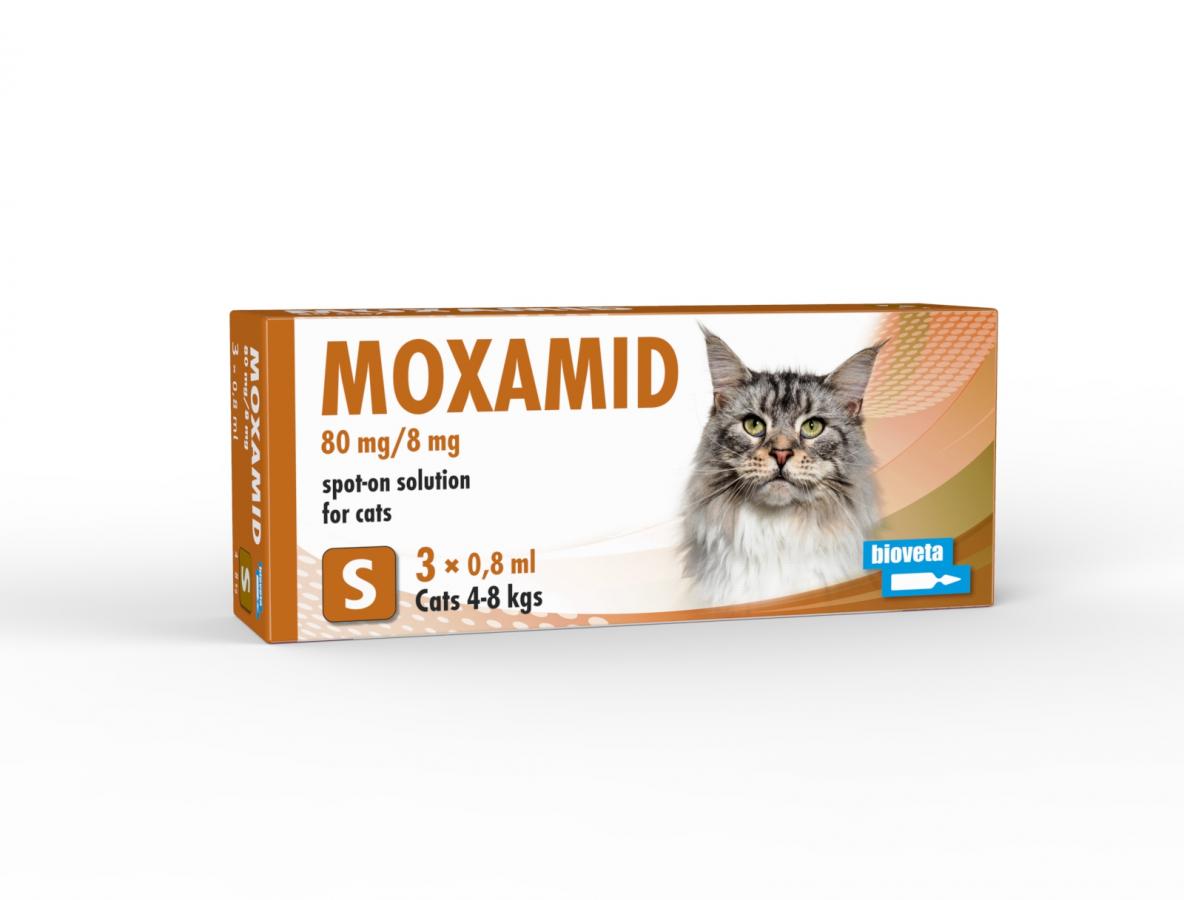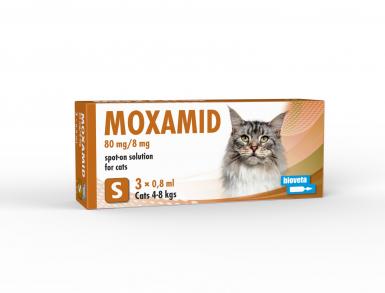Moxamid 80 mg/8 mg spot-on solution for cats
Homepage Products Veterinary products Moxamid 80 mg/8 mg spot-on solution for cats
Antiparasitic preparation for application to the skin with effectiveness against internal and external parasites.
| type of preparative: | Antiparasitics |
|---|---|
| target species animals: | Cat |
Active substances:
One pipette (0,8 ml) contains:
Active substances:
Imidaclopridum 80 mg
Moxidectinum 8 mg
Excipients:
Butylhydroxytoluen 0,8 mg
Benzylalkohol 658 mg
PHARMACEUTICAL FORM
Spot-on solution
Clear yellow to brownish solution
CLINICAL PARTICULARS
Target species
Cats 4-8 kgs
Indications for use, specifying the target species
For cats suffering from, or at risk from, mixed parasitic infections:
∙ the treatment and prevention of flea infestation (Ctenocephalides felis),
∙ the treatment of ear mite infestation (Otodectes cynotis),
∙ the treatment of notoedric mange (Notoedres cati),
∙ the treatment of the lungworm Eucoleus aerophilus (syn. Capillaria aerophila) (adults),
∙ the prevention of lungworm disease (L3/L4 larvae of Aelurostrongylus abstrusus),
∙ the treatment of the lungworm Aelurostrongylus abstrusus (adults),
· the treatment of the lungworm Troglostrongylus brevior (adults),
∙ the treatment of the eye worm Thelazia callipaeda (adults),
∙ the prevention of heartworm disease (L3 and L4 larvae of Dirofilaria immitis),
∙ the treatment of infections with gastrointestinal nematodes (L4 larvae, immature adults and adults of Toxocara cati and Ancylostoma tubaeforme).
The product can be used as part of a treatment strategy for flea allergy dermatitis (FAD).
Contraindications
Do not use in kittens under 9 weeks of age.
Do not use in cases of hypersensitivity to the active substances or to any of the
excipients.
For ferrets: do not use Moxamid for big cats (0.8 ml) or Moxamid for dogs (all sizes).
Do not use on canaries.
Special warnings for each target species
The product’s efficacy has not been tested in ferrets weighing over 2 kg and therefore the duration of effect might be shorter in these animals.
Brief contact of the animal with water on one or two occasions between monthly
treatments is unlikely to significantly reduce the efficacy of the product. However,
frequent shampooing or immersion of the animal in water after treatment may reduce
the efficacy of the product.
The use of the product should be based on the confirmed diagnosis of mixed
infection (or risk of infection, where prevention applies) at the same time
Efficacy against adult Dirofilaria repens has not been tested under field conditions.
Special precautions for use
Special precautions for use in animals
The treatment of cats weighing less than 1 kg and ferrets weighing less than 0.8 kg should be based on a benefit-risk assessment..
There is limited experience on the use of the product in sick and debilitated animals,
thus the product should only be used based on a benefit-risk assessment for these
animals.
Do not apply in the mouth, in the eyes or the ears of the animal.
Care should be taken that the product is not ingested by animals and does not come
into contact with the eyes or mouth of the recipient and/or other animals.
Do not allow recently treated animals to groom each other. Do not allow treated
animals to come into contact with untreated animals until the application site is dry.
When the product is applied in 3 to 4 separate spots (see section 4.9), specific care
should be taken to prevent the animal licking the application sites.
Moxamid should not enter water courses as it has harmful effects on aquatic
organisms: moxidectin is highly toxic to aquatic organisms.
Imidacloprid is toxic for birds, especially canaries.
Avoid contact with skin, eyes or mouth. Do not eat, drink or smoke during application.
Wash hands thoroughly after use.
After application do not stroke or groom animals until the application site is dry.
In case of accidental spillage onto skin, wash off immediately with soap and water.
People with a known hypersensitivity to benzyl alcohol, imidacloprid or moxidectin
should administer the product with caution. In very rare cases the product may cause
skin sensitisation or transient skin reactions (for example numbness, irritation or
burning/tingling sensation).
In very rare cases the product may cause respiratory irritation in sensitive individuals.
If the product accidentally gets into eyes, they should be thoroughly flushed with
water.
Adverse reactions
|
Uncommon (1 - 10 animals / 10 000 animals): |
Seborrhea, redness Vomiting |
|
Rare (<1 animal / 10 000 animals, including sporadic reports) |
Local alergic reaction Neurological symptoms Changes of behavior (lethargy, restlesness, innapetence)3 |
|
Unknown frequency
|
Pruritus Salivation |
Use during pregnancy, lactation or lay
The safety of the veterinary medicinal product has not been established during
pregnancy and lactation in the target species. Therefore, the use of the product is not
recommended in animals intended for breeding or during pregnancy and lactation.
Interaction with other medicinal products and other forms of interaction
During treatment with Moxamid no other antiparasitic macrocyclic lactone should be
administered. Safety of Moxamid when administered on the same day as an adulticide to remove adult heartworms has not been evaluated.
Amounts to be administered and administration route
Dosage schedule:
The recommended minimum doses are 10 mg/kg body weight imidacloprid and
1,0 mg/kg body weight moxidectin, equivalent to 0.1 ml/kg body weight.
|
Body weight [kg] |
Size of pippete |
Volume [ml] |
Imidaclopride [mg/kg b.w.] |
Moxidectin [mg/kg b.w.] |
|
4 -8 kg |
Moxamid for small cats and ferrets |
0,8 |
minimum 10 |
minimum 1,0 |
Flea treatment and prevention (Ctenocephalides felis)
One treatment prevents future flea infestation for 4 weeks. Existing pupae in the environment may emerge for 6 weeks or longer after treatment is initiated, depending upon climatic conditions. Therefore, it may be necessary to combine Moxamid treatment with environmental treatments aimed at breaking the flea life cycle in the surroundings. This can result in a more rapid reduction in the household flea population. The product should be administered at monthly intervals when used as part of a treatment strategy for flea allergy dermatitis.
Treatment of ear mite infestation (Otodectes cynotis)
A single dose of the product should be administered. A further veterinary examination 30 days after treatment is recommended as some animals may require a second treatment. Do not apply directly to the ear canal.
Treatment of notoedric mange (Notoedres cati)
A single dose of the product should be administered.
Treatment of the lungworm Eucoleus aerophilus (syn. Capillaria aerophila) (adults)
A single dose of the product should be administered.
Prevention of Aelurostrongylus abstrusus
The product should be administered monthly.
Treatment of Aelurostrongylus abstrusus
Moxamid should be administered monthly for three consecutive months.
Treatment of Troglostrongylus brevior (adults)
Moxamid should be administered monthly for two consecutive months.
Treatment of the eye worm Thelazia callipaeda (adults)
A single dose of the product should be administered.
Heartworm prevention (Dirofilaria immitis)
Cats in areas endemic for heartworm, or those which have travelled to endemic areas, may be infected with adult heartworms. Therefore prior to treatment with Moxamid, the advice provided in section, 'Special precautions for use' should be considered.
For prevention of heartworm disease, the product must be applied at regular monthly intervals during the time of the year when mosquitoes (the intermediate hosts which carry and transmit heartworm larvae) are present. The product may be administered throughout the year. The first dose may be given after first possible exposure to mosquitoes, but not more than one month after this exposure. Treatment should continue at regular monthly intervals until 1 month after the last exposure to mosquitoes. To establish a treatment routine, it is recommended that the same day or date be used each month. When replacing another heartworm preventative product in a heartworm prevention programme, the first treatment with Moxamid must be given within 1 month of the last dose of the former medication.
In non-endemic areas there should be no risk of cats having heartworm. Therefore, they can be treated without special precautions.
Roundworm and hookworm treatment (Toxocara cati and Ancylostoma tubaeforme)
In areas endemic for heartworm, monthly treatment may significantly reduce the risk of re-infection caused by the respective roundworms and hookworms. In areas non-endemic for heartworm, the product can be used as part of a seasonal prevention programme against fleas and gastrointestinal nematodes.
Method of administration
Hold the tube with the neck up and tap the neck several times with your finger. Gently break off the tip with a twisting motion.
On a standing cat spread the fur between the shoulder blades so that the skin is visible. Apply to intact skin. Place the tip of the tube on the skin and apply the contents directly to the skin by repeatedly squeezing the tube
Overdose (symptoms, emergency procedures, antidotes), if necessary
Cats tolerated up to 10 times the recommended dose without adverse effects or adverse clinical signs.
The product was administered at 5 times the recommended dose to the kittens every two weeks for a total of 6 treatments and no serious clinical signs occurred. Transient mydriasis, salivation, vomiting and rapid breathing were observed.
In accidental ingestion or after overdose, neurological symptoms (most of them transient) such as ataxia, generalised convulsions, ocular symptoms (dilated pupils, weak pupillary reflex, nystagmus), abnormal breathing, salivation and vomiting may occur very rarely. The product was administered at 5 times the recommended dose to ferrets every two weeks for a total of 4 treatments and no adverse effects or adverse clinical signs were observed.
Withdrawal period(s)
Not applicable.
PHARMACOLOGICAL PROPERTIES
Pharmacotherapeutic group: Antiparasitic products, insecticides and repellents,
macrocyclic lactones, milbemycins.
Pharmacodynamic properties
Imidacloprid, 1-(6-Chloro-3-pyridylmethyl)-N-nitro-imidazolidin-2-ylideneamine is an
ectoparasiticide belonging to the chloronicotinyl group of compounds. Chemically, it
is more accurately described as a chloronicotinyl nitroguanidine. Imidacloprid is
effective against larval flea stages and adult fleas. Flea larvae in the pet’s
surroundings are killed after contact with a pet treated with the product. Imidacloprid
has a high affinity for the nicotinergic acetylcholine receptors in the post-synaptic
region of the central nervous system (CNS) of the flea. The ensuing inhibition of
cholinergic transmission in insects results in paralysis and death. Due to the weak
nature of the interaction with mammalian nicotinergic receptors and the postulated
poor penetration through the blood-brain barrier in mammals, it has virtually no effect
on the mammalian CNS. Imidacloprid has minimal pharmacological activity in
mammals.
Moxidectin, 23-(O-methyloxime)-F28249 alpha is a second-generation macrocyclic
lactone of the milbemycin family. It is a parasiticide which is active against many
internal and external parasites. Moxidectin is active against larval stages of Dirofilaria
immitis (L1, L3, L4) and Dirofilaria repens (L1, L3). It is also active against
gastrointestinal nematodes. Moxidectin interacts with GABA and glutamate-gated
chloride channels. This leads to opening of the chloride channels on the postsynaptic
junction, the inflow of chloride ions and induction of an irreversible resting state. The product has a lasting effect and protects cats for 4 weeks after a single administration against reinfection with Dirofilaria immitis.
Pharmacokinetics
After topical administration, imidacloprid is rapidly distributed in the skin of the animal within one day after administration. It is present on the surface of the body throughout its duration of action. Moxidectin is absorbed through the skin and reaches maximum plasma concentrations approximately 1 to 2 days after treatment in cats. After absorption through the skin, moxidectin is distributed throughout the body, but due to its lipophilicity it is concentrated predominantly in fat. It is eliminated slowly from the plasma, which is reflected in the fact that plasma concentrations of moxidectin are detectable throughout the month of treatment.
The average t½ in cats is between 18.7 and 25.7 days.
Studies evaluating the pharmacokinetic behaviour of moxidectin after repeated administration have shown that steady-state serum levels are reached in cats after approximately 4 consecutive monthly treatments.
Shelf life
Shelf life of the veterinary medicinal product as packaged for sale: 2 years.
Special precautions for storage
Do not store above 30 °C.
Pack sizes: 1 or 3 single-dose pipettes.
All pack sizes may not be available on the market










